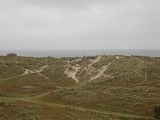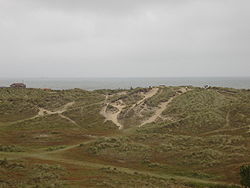
Winterton Dunes
Encyclopedia
Winterton Dunes is an extensive dune
system on the east coast of Norfolk
, England
, which has been designated as a National Nature Reserve
and is within the Norfolk Coast AONB
.
 The site is unusual in that it shows greater ecological similarities to the dune systems of the Baltic
The site is unusual in that it shows greater ecological similarities to the dune systems of the Baltic
- which support acidic plant communities - rather than the dunes on the North Norfolk Coast - where the sand is calcareous
.
The site supports well developed areas of dune heath
, wet 'slacks' between dunes and dune grassland
which grades into grazing marsh
and birch
woodland
.
Natterjack Toad
s breed in shallow pools within the site. The site, along with the adjoining Horsey Dunes
, hosts the largest colonies of Dark Green Fritillary
and Grayling
butterflies in Norfolk. Other butterflies recorded from here in numbers include Small Copper
and Common Blue
.
The ponds among the dunes are home to many dragonflies including the Common Hawker
- which is rare in Norfolk.
Winterton Dunes is also known as the first site in Britain where the Southern Emerald Damselfly occurred (Nobes 2003).
Winterton has suffered from extensive coastal erosion
and is threatened by sea-level rise.
Dune
In physical geography, a dune is a hill of sand built by wind. Dunes occur in different forms and sizes, formed by interaction with the wind. Most kinds of dunes are longer on the windward side where the sand is pushed up the dune and have a shorter "slip face" in the lee of the wind...
system on the east coast of Norfolk
Norfolk
Norfolk is a low-lying county in the East of England. It has borders with Lincolnshire to the west, Cambridgeshire to the west and southwest and Suffolk to the south. Its northern and eastern boundaries are the North Sea coast and to the north-west the county is bordered by The Wash. The county...
, England
England
England is a country that is part of the United Kingdom. It shares land borders with Scotland to the north and Wales to the west; the Irish Sea is to the north west, the Celtic Sea to the south west, with the North Sea to the east and the English Channel to the south separating it from continental...
, which has been designated as a National Nature Reserve
National Nature Reserve
For details of National nature reserves in the United Kingdom see:*National Nature Reserves in England*National Nature Reserves in Northern Ireland*National Nature Reserves in Scotland*National Nature Reserves in Wales...
and is within the Norfolk Coast AONB
Norfolk Coast AONB
The Norfolk Coast Area of Outstanding Natural Beauty covers over 450 km2 of coastal and agricultural land from the The Wash in the west through coastal marshes and cliffs to the sand dunes at Winterton in the east....
.

Baltic region
The terms Baltic region, Baltic Rim countries, and Baltic Rim refer to slightly different combinations of countries in the general area surrounding the Baltic Sea.- Etymology :...
- which support acidic plant communities - rather than the dunes on the North Norfolk Coast - where the sand is calcareous
Calcareous
Calcareous is an adjective meaning mostly or partly composed of calcium carbonate, in other words, containing lime or being chalky. The term is used in a wide variety of scientific disciplines.-In zoology:...
.
The site supports well developed areas of dune heath
Heath
-Habitats:* Heath or heathland, low-growing woody vegetation, mostly consisting of heathers and related species* Heaths in the British National Vegetation Classification system...
, wet 'slacks' between dunes and dune grassland
Grassland
Grasslands are areas where the vegetation is dominated by grasses and other herbaceous plants . However, sedge and rush families can also be found. Grasslands occur naturally on all continents except Antarctica...
which grades into grazing marsh
Grazing marsh
Grazing marsh is a British Isles term for flat, marshy grassland in polders. It consists of large grass fields separated by fresh or brackish ditches, and is often important for its wildlife.-History:...
and birch
Birch
Birch is a tree or shrub of the genus Betula , in the family Betulaceae, closely related to the beech/oak family, Fagaceae. The Betula genus contains 30–60 known taxa...
woodland
Woodland
Ecologically, a woodland is a low-density forest forming open habitats with plenty of sunlight and limited shade. Woodlands may support an understory of shrubs and herbaceous plants including grasses. Woodland may form a transition to shrubland under drier conditions or during early stages of...
.
Natterjack Toad
Natterjack Toad
The Natterjack Toad is a toad native to sandy and heathland areas of Europe. Adults are 60–70 mm in length and are distinguished from Common Toads by a yellow line down the middle of the back...
s breed in shallow pools within the site. The site, along with the adjoining Horsey Dunes
Horsey Dunes
Horsey Dunes is an extensive dune system on the east coast of Norfolk, England. It is owned by the National Trust and is within the Norfolk Coast AONB. It is sometimes known as Horsey Gap...
, hosts the largest colonies of Dark Green Fritillary
Dark Green Fritillary
The Dark Green Fritillary is a butterfly of the Nymphalidae family.The insect has a wide range in the Palearctic ecozone - Europe, Morocco, Iran , Siberia, Central Asia, China, Korea and Japan.-Subspecies:...
and Grayling
Grayling (butterfly)
The Grayling is a species in the brush-footed butterfly family Nymphalidae. It sometimes occurs in coastal areas of northeast Scotland such as the Fowlsheugh Nature Reserve. It can also be found near the coast around England, such as Fire Beacon Hill...
butterflies in Norfolk. Other butterflies recorded from here in numbers include Small Copper
Small Copper
The Small Copper, American Copper, or the Common Copper is a butterfly of the Lycaenids or gossamer-winged butterfly family.- Description :thumb|left|Larva...
and Common Blue
Common Blue
The Common Blue is a small butterfly in the family Lycaenidae, widespread over much of the Palaearctic. Recently, Polyommatus icarus was discovered in Mirabel, Quebec, Canada by Ara Sarafian, an amateur entomologist who observed the butterfly from 2005 to 2008...
.
The ponds among the dunes are home to many dragonflies including the Common Hawker
Common Hawker
The Common Hawker or Sedge Darner is one of the larger species of hawker dragonflies. It is native to Eurasia and northern North America. The flight period is from June to early October.It is long with a brown body...
- which is rare in Norfolk.
Winterton Dunes is also known as the first site in Britain where the Southern Emerald Damselfly occurred (Nobes 2003).
Winterton has suffered from extensive coastal erosion
Coastal erosion
Coastal erosion is the wearing away of land and the removal of beach or dune sediments by wave action, tidal currents, wave currents, or drainage...
and is threatened by sea-level rise.

